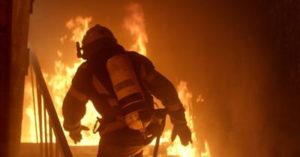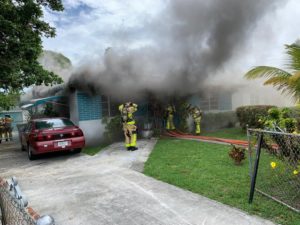The smoke released by any type of fire (forest, brush, crop, structure, tires, waste or wood burning) is a mixture of particles and chemicals produced by incomplete burning of carbon-containing materials. All smoke contains carbon monoxide, carbon dioxide and particulate matter (PM or soot). Smoke can contain many different chemicals, including aldehydes, acid gases, sulfur dioxide, nitrogen oxides, polycyclic aromatic hydrocarbons (PAHs), benzene, toluene, styrene, metals and dioxins. The type and amount of particles and chemicals in smoke varies depending on what is burning, how much oxygen is available, and the burn temperature.
Exposure to high levels of smoke should be avoided. Individuals are advised to limit their physical exertion if exposure to high levels of smoke cannot be avoided. Individuals with cardiovascular or respiratory conditions (e.g., asthma), fetuses, infants, young children, and the elderly may be more vulnerable to the health effects of smoke exposure.
Inhaling smoke for a short time can cause immediate (acute) effects. Smoke is irritating to the eyes, nose, and throat, and its odor may be nauseating. Studies have shown that some people exposed to heavy smoke have temporary changes in lung function, which makes breathing more difficult. Two of the major agents in smoke that can cause health effects are carbon monoxide gas and very small particles (fine particles, or PM2.5 ). These particles are two and one half (2.5) microns or less in size (25,400 microns equal an inch) and individual particles are too small to be seen with the naked eye.
Inhaling carbon monoxide decreases the body’s oxygen supply. This can cause headaches, reduce alertness, and aggravate a heart condition known as angina. Fine particles are able to travel deeply into the respiratory tract, reaching the lungs. Inhaling fine particles can cause a variety of health effects, including respiratory irritation and shortness of breath, and can worsen medical conditions such as asthma and heart disease. During increased physical exertion, cardiovascular effects can be worsened by exposure to carbon monoxide and particulate matter. Once exposure stops, symptoms from inhaling carbon monoxide or fine particles generally diminish, but may last for a couple of days.
More than half of fire-related deaths result from smoke inhalation, according to the Burn Institute. Smoke inhalation occurs when you breathe in harmful smoke particles and gases. Inhaling harmful smoke can inflame your lungs and airway, causing them to swell and block oxygen. This can lead to acute respiratory distress syndrome and respiratory failure.
Smoke inhalation commonly happens when you get trapped in a contained area, such as a kitchen or home, near a fire. Most fires occur in the home, often from cooking, fireplaces and space heaters, electrical malfunctions, and smoking.
Avoiding smoky situations is the best way to avoid exposure. If your age or health status places you at greater risk from smoke exposure you should speak with your doctor about alternative steps you can take when encountering smoky situations. Anyone with persisting or frequent symptoms that they think are associated with smoke exposure should see their health care provider. Additional information on carbon monoxide and fine particles can be found at the web addresses listed at the end of this fact sheet.
There is also the potential for chronic health effects from exposure to the components of smoke. Long term exposure to ambient air containing fine particles has been associated with increases in cardiovascular disease and mortality in populations living in areas with higher fine particulate air pollution. Frequent exposure to smoke for brief periods may also cause long-term health effects. Firefighters, who are exposed frequently to smoke, have been examined for long-term health effects (for example, cancer, lung disease, and cardiovascular disease) of repeated smoke exposures. The findings from these studies are not consistent or conclusive. Some studies show an increased frequency of these diseases among firefighters compared to similar male reference populations (e.g., male policemen, white males in the general population), while others do not.
When it is necessary to work in heavy smoke, use appropriate respiratory protection to reduce exposure to the particles and gases in smoke.



